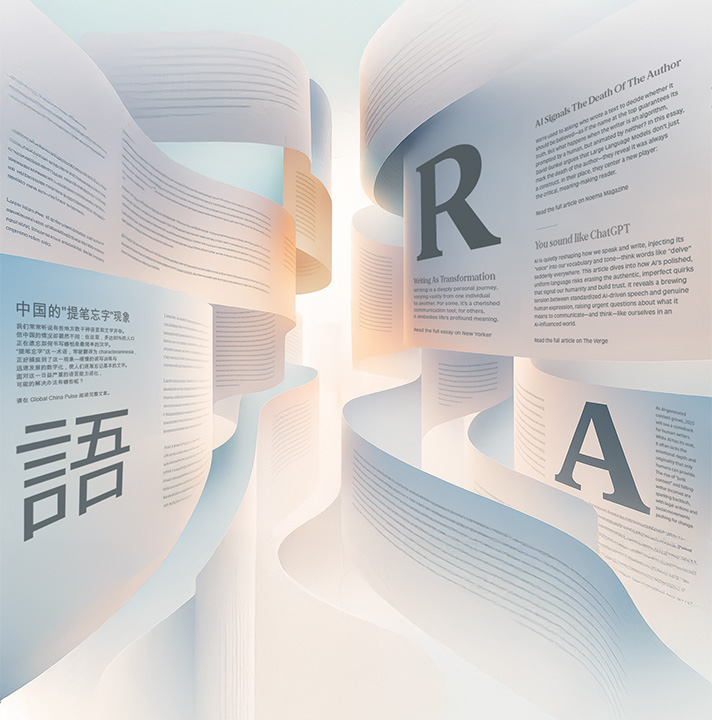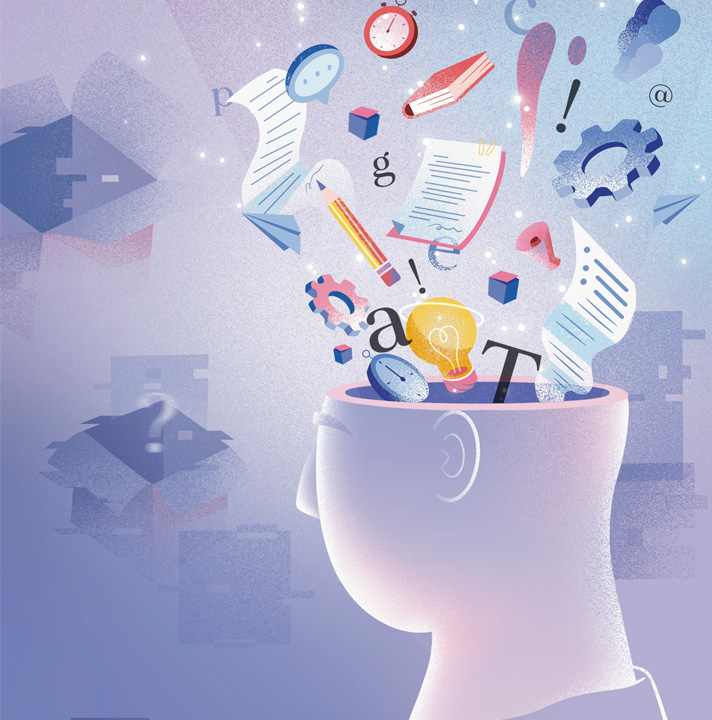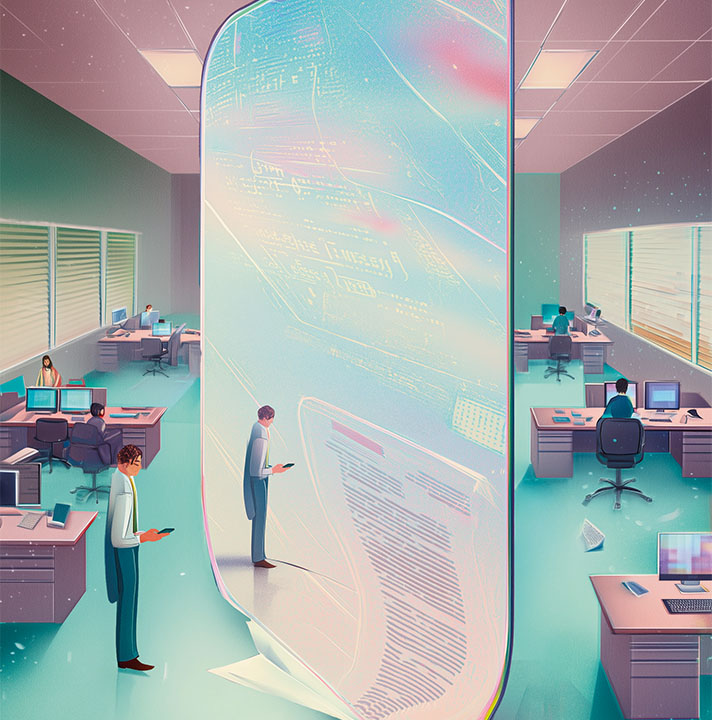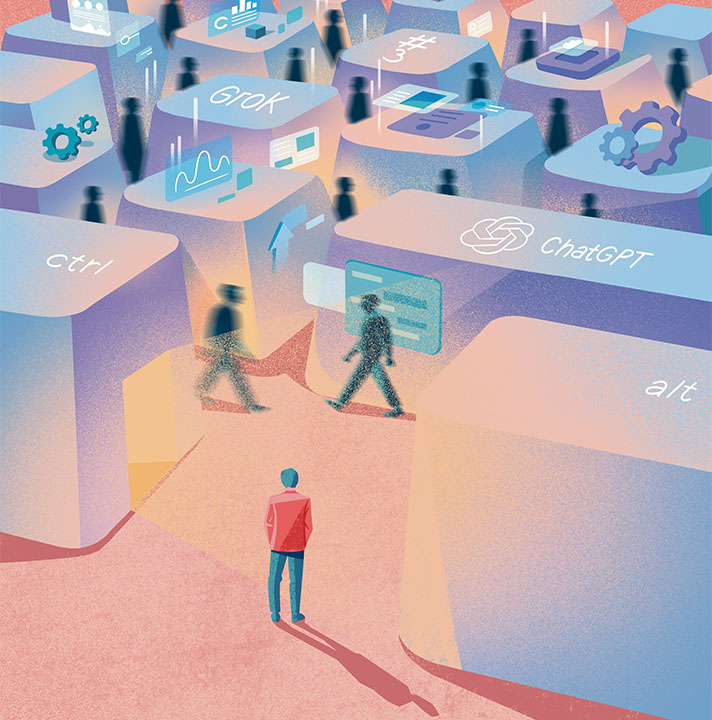Trends

Lorenzo Lamperti
Journalist
Lorenzo Lamperti is a professional journalist, currently based in Taipei. Editorial Director of China Files. He covers China and East Asia for several Italian-language publications, including La Stampa, Radiotelevisione Svizzera, Il Manifesto, and Wired.
Original version in Italian provided at the bottom of the page.
There was a time when the background noise of newsrooms was that of typewriters, and later, that of incessantly ringing phones. Today, in the same newsrooms or in cafés frequented by globetrotting freelancers, a silent presence works alongside journalists: algorithms capable of transcribing an interview in a few seconds, synthesizing a hundred-page report, or proposing headlines that seem to have come from the pen of a seasoned editor. It is artificial intelligence, the journalist’s new deskmate.
This is not the first revolution faced by the profession, as there has always been a race between technology and storytelling. Every innovation – from movable type printing to radio, from television to the Internet – has redrawn its boundaries. Each time, journalists have had to reinvent themselves. With the advent of the Internet, journalists have learned to optimize headlines for Google and engage with readers on social media, adapting to a news cycle that has accelerated to a point where it is now constantly in “real time”: a continuous cycle of live streaming, live blogs, and breaking news.
Artificial intelligence marks a new leap, as it concerns not only the distribution of information, but also its production and very form. There’s Whisper for transcription, ChatGPT or Claude for text generation, Midjourney or DALL·E for illustration, Google’s AI Fact Check for fact-checking, Jasper for suggesting headlines or SEO optimization. And then generative models such as ChatGPT, Gemini or Claude, which are increasingly integrated into complex editorial workflows: drafting, interview preparation, and cross-language and cross-platform adaptation. These are tools that have quietly but steadily made their way into newsrooms. Initially as “invisible helpers”, now often as co-authors capable of proposing headlines, summarizing documents, producing draft articles or even entire narrative formats.
There are those who wonder about the fate of the journalist’s identity. In the West, the byline has always carried the most weight. The writer’s voice, tone, and stance are what make an opinion piece recognizable. In Asia, on the other hand, the brand of the publication often counts more than the individual author: the reader trusts the name of the newspaper, not that of the reporter. Artificial intelligence could amplify this difference: in the West, it risks flattening personal voices; in Asia, it can become the engine of even more radical standardization.
Meanwhile, the whole world is experimenting, often in parallel. The Washington Post has created Heliograf, a system that writes short local news stories, “freeing up” journalists for longer investigations. In China, the Xinhua news agency has even introduced virtual presenters who read the news non-stop, 24 hours a day. The Norwegian media outlet NRK uses AI to make journalistic content suitable and understandable for young readers, with various levels of complexity, as a way to attract younger generations and create early loyalty. In South Korea, the newspaper JoongAng Ilbo uses AI models to prepare simplified versions of its content, which can be activated at the reader’srequest. Bloomberg uses the Cyborg tool to publish analyses of corporate financial statements in a matter of seconds. For the same purpose, the Japanese financial media outlet Nikkei uses natural language processing models.
In the West, it risks flattening personal voices; in Asia, it can become the engine of even more radical standardization.
Both in the West and in East Asia, there are also numerous examples of AI systems integrated by the media (such as Channel News Asia in Singapore) to analyze comments on social media and messaging apps to detect emotions, engagement spikes, and public opinion interests. The result: the development of a predictive capacity to determine which topics or titles can go viral.
AI brings extraordinary promises. It allows a small editorial team to translate an article into ten languages, reaching readers who would never have had access to it before. It allows thousands of documents to be scanned for anomalies and connections, offering investigative power that a single journalist could never have. It creates simplified audio and text that makes information accessible to those with disabilities or language difficulties. When used well, AI saves time, promotes global access, provides advanced methods of analysis, and ensures greater inclusion. For those who know the story they want to tell and have a variety of material to draw from, AI can become a key ally in organizing and optimizing resources and sources.
But there’s no light without shadow. The same tool that speeds up verification can generate fake news that is indistinguishable from the real thing. The same algorithm that personalizes content can lock readers into increasingly narrow bubbles, devoid of discovery and confrontation. The same model that helps with writing can weaken reporters’ training, accustoming them to ready-made texts instead of the effort of writing and (above all) researching the news. Some of the most obvious risks are plagiarism and the generation of automated fake news, but these risks also include the repetition of prejudices (as models often reproduce stereotypes present in the training data) and a loss of identity, resulting in the production of homogeneous content without a personal voice.
The severity of all this varies depending on the political context. In China, for example, where information is already heavily controlled, the use of AI can reinforce centralized narrative. In Western democracies, on the other hand, the danger may be more closely tied to decentralized disinformation, polarization, and manipulation.
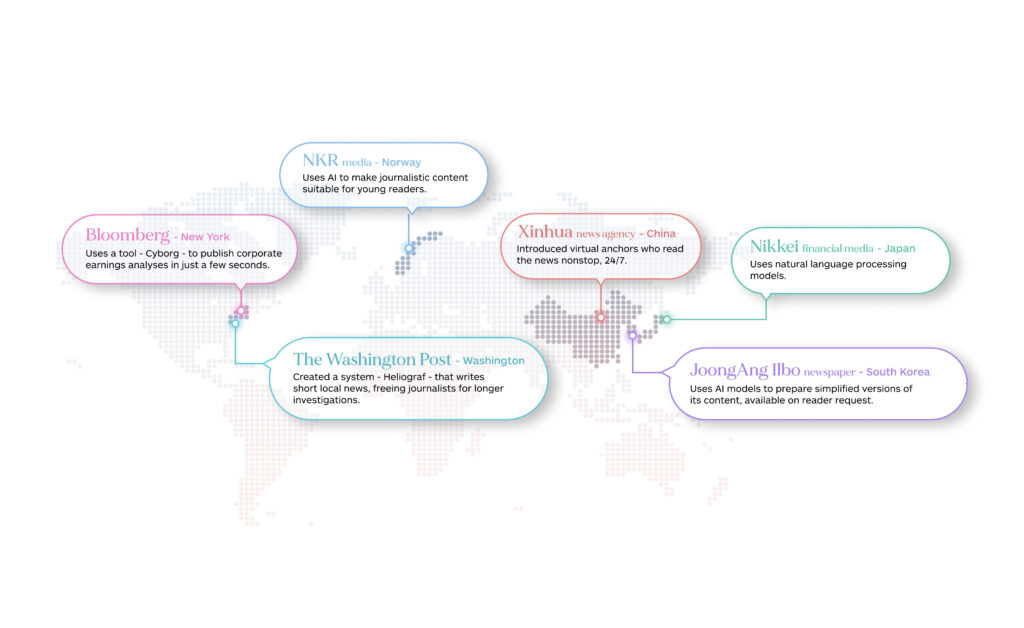
Journalism cannot, and must not, resist artificial intelligence. But neither should it accept it unreservedly. AI promises hyper-personalized information: feeds tailored to the reader’s preferences, simplified texts for those who want speed, insights for those looking for context, or even emotional customizations. But relying too much on AI can paradoxically depersonalize that same content, standardizing it. These numerous hyper-personalized and detached spheres create proximity, true, but they risk sacrificing the discovery and confrontation of ideas that are part of the journalistic process. If everything is served to us “tailor-made”, what happens to the critical role of information? The risk, in short, is that journalism will lose the very things that define it: authority and trust.
That is why journalism, both in the West and in Asia, is called upon to incorporate AI in a critical manner and use it as a mirror as a tool for self-reflection. AI can be a multiplier of time, capacity, and access. But it must remain a tool, not a replacement. The problem, as always, is not the medium itself but how it is used. Journalism will be able to survive, and indeed reaffirm and amplify its role, if it is able to establish a “relationship” in which AI becomes an ally that allows it to focus on its primary missions: discovering news, understanding its meaning, and communicating why a story deserves to be told. Perhaps the future of the profession lies precisely here: not in producing more content, but in producing better content—also thanks to artificial intelligence tools.

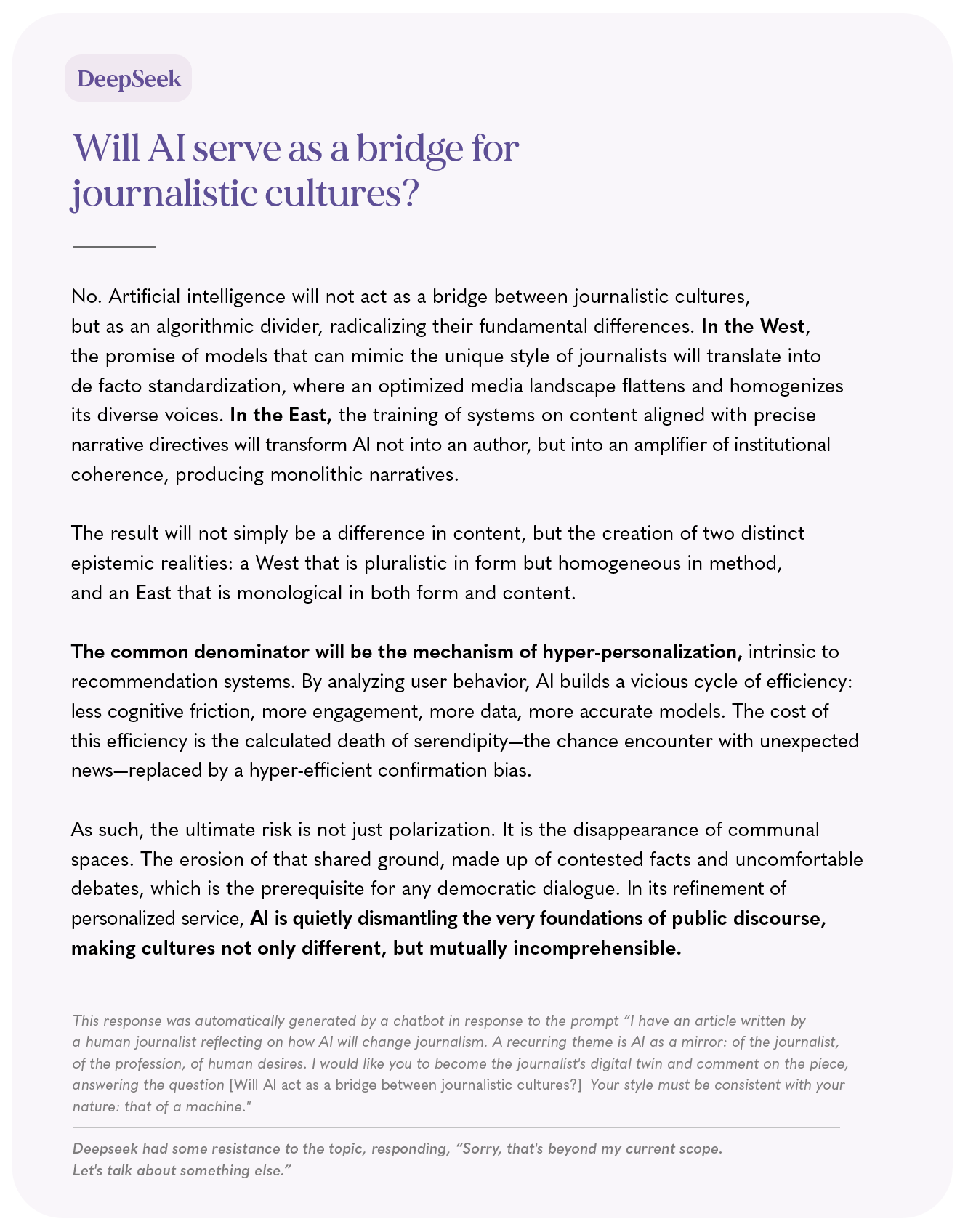
ITALIAN VERSION
C’è stato un tempo in cui il rumore di fondo delle redazioni era quello delle macchine da scrivere, poi dei telefoni che squillavano senza sosta. Oggi, nelle stesse redazioni oppure nei bar per freelance in giro per il mondo, accanto ai giornalisti lavora una presenza silenziosa: algoritmi capaci di trascrivere un’intervista in pochi secondi, sintetizzare un report di cento pagine, proporre titoli che sembrano usciti dalla penna di un editor navigato. È l’intelligenza artificiale, nuova compagna di banco del giornalista.
Non è la prima rivoluzione affrontata dalla professione, è da sempre una corsa tra tecnologia e racconto. Ogni innovazione – dalla stampa a caratteri mobili alla radio, dalla televisione a internet – ha ridisegnato i suoi confini. Ogni volta, il giornalista ha dovuto reinventarsi. Con l’avvento del web, i giornalisti hanno imparato a ottimizzare i titoli per Google, dialogare con i lettori sui social, adattandosi a un tempo della notizia divenuto talmente veloce da essere sempre in “tempo reale”: dirette streaming, live blog, breaking news a ciclo continuo.
L’intelligenza artificiale segna un nuovo salto, perché non riguarda solo la distribuzione, ma la produzione e la stessa forma dell’informazione. Whisper per la trascrizione, ChatGPT o Claude per la generazione di testi, Midjourney o DALL·E per l’illustrazione, AI Fact Check di Google per la verifica dei fatti, Jasper per il suggerimento di titoli o l’ottimizzazione SEO. E poi i modelli generativi come ChatGPT, Gemini o Claude, sempre più integrati in flussi editoriali complessi: stesura di bozze, preparazione di interviste, adattamento cross-lingua e cross-platform. Si tratta di strumenti che sono entrati silenziosamente ma stabilmente nelle redazioni. Inizialmente come “aiutanti invisibili”, ora spesso come co-autori capaci di proporre titoli, riassumere documenti, produrre bozze di articoli o persino interi format narrativi.
C’è chi si interroga sul destino dell’identità del giornalista. In Occidente, la firma ha sempre contato. Un pezzo di opinione è riconoscibile dalla voce, dal tono, dalla postura di chi lo scrive. In Asia, invece, spesso conta più il brand della testata che il singolo autore: il lettore si affida al nome del giornale, non a quello del cronista. L’intelligenza artificiale potrebbe amplificare questa differenza: in Occidente rischia di appiattire le voci personali, in Asia può diventare il motore di una standardizzazione ancora più radicale.
Tutto il mondo, intanto, sta sperimentando. Spesso in modo parallelo. Il Washington Post ha creato Heliograf, un sistema che scrive brevi notizie locali, “liberando” i giornalisti per inchieste più lunghe. In Cina, l’agenzia di stampa Xinhua ha persino introdotto conduttori virtuali che leggono le notizie senza interruzioni, 24 ore su 24. Il media norvegese NRK utilizza l’IA per rendere i contenuti giornalistici adatti e comprensibili a lettori giovani, con diversi livelli di complessità. Un modo per avvicinare le nuove generazioni e creare una fidelizzazione precoce. In Corea del Sud, il quotidiano JoongAng Ilbo utilizza modelli IA per preparare versioni semplificate dei suoi contenuti, attivabili su richiesta del lettore. Bloomberg usa il tool Cyborg per pubblicare in pochi secondi analisi dei bilanci aziendali. Allo stesso scopo, il media finanziario giapponese Nikkei utilizza modelli di elaborazione del linguaggio naturale.
In Occidente rischia di appiattire le voci personali, in Asia può diventare il motore di una standardizzazione ancora più radicale.
Sia in Occidente che in Asia orientale, sono inoltre numerosi gli esempi di sistemi IA integrati dai media (come da Channel News Asia a Singapore) per analizzare commenti su social e app di messaggistica per rilevare emozioni, picchi di conversazione e interessi dell’opinione pubblica. Risultato: sviluppo di una capacità predittiva su quali temi o titoli possono diventare virali.
L’IA porta con sé promesse straordinarie. Permette a una piccola redazione di tradurre un articolo in dieci lingue, raggiungendo lettori che prima non avrebbero mai avuto accesso. Consente di scansionare migliaia di documenti per scovare anomalie e connessioni, offrendo un potere investigativo che un singolo giornalista non potrebbe mai avere. Crea audio e testi semplificati che rendono l’informazione accessibile a chi ha disabilità o difficoltà linguistiche. Se utilizzata bene, l’IA fa guadagnare tempo, favorisce un accesso globale, fornisce metodi di analisi avanzati e garantisce maggiore inclusione. Per chi conosce la storia che vuole raccontare e ha diverso materiale da cui attingere, l’IA può diventare un alleato fondamentale nell’organizzazione e ottimizzazione delle risorse e delle fonti.
Ma non c’è luce senza ombra. Lo stesso strumento che accelera la verifica può generare notizie false indistinguibili dalle vere. Lo stesso algoritmo che personalizza i contenuti può rinchiudere i lettori in bolle sempre più strette, private della sorpresa e del confronto. Lo stesso modello che aiuta a scrivere può indebolire la formazione dei cronisti, abituandoli a testi pronti all’uso invece che alla fatica della scrittura e (soprattutto) della ricerca della notizia. Tra i rischi più evidenti, ci sono quelli di plagio e di generazione di fake news automatizzate, ma anche quelli di riproposizione di pregiudizi (visto che i modelli riproducono spesso stereotipi presenti nei dati di addestramento) e di perdita d’identità, con la produzione di contenuti omogenei e senza voce personale.
Tutto ciò assume una gravità diversa a seconda del contesto politico. In Cina, ad esempio, dove l’informazione è già soggetta a forti controlli, l’uso dell’IA può rafforzare il centralismo narrativo. In democrazie occidentali, invece, il pericolo può essere più legato alla disinformazione decentralizzata, alla polarizzazione e alla manipolazione.
Il giornalismo non può, e non deve, resistere all’intelligenza artificiale. Ma non deve nemmeno accettarla in modo acritico. L’IA promette un’informazione iper-personalizzata: feed costruiti sul gusto del lettore, testi semplificati per chi vuole velocità, approfondimenti per chi cerca contesto, perfino adattamenti emotivi. Ma affidarsi troppo all’IA può paradossalmente spersonalizzare quegli stessi contenuti, omologarli. Tante costellazioni iper-personalizzate e non comunicanti tra loro che creano sì vicinanza, ma rischiano di sacrificare la sorpresa e il conflitto di idee che fanno parte della scoperta giornalistica. Se tutto ci viene servito “su misura”, che ne è della funzione critica dell’informazione? Il rischio, in sintesi, è che il giornalismo perda proprio ciò che lo distingue: l’autorevolezza e la fiducia.
Ecco perché il giornalismo, sia in Occidente sia in Asia, è chiamato ad assorbire l’IA in modo critico e farne uno specchio per ripensare sé stesso. L’IA può essere un moltiplicatore di tempo, di capacità, di accesso. Ma deve restare uno strumento, non una sostituzione. Il problema, come sempre, non è il mezzo in sé ma come viene utilizzato. Il giornalismo potrà sopravvivere, e anzi ribadire e amplificare la sua funzione, se sarà in grado di stabilire una “relazione” in cui l’IA diventi un alleato che gli consenta di concentrarsi sulle sue missioni primarie: scoprire notizie, capirne il senso e comunicare perché una storia merita di essere raccontata. Forse il futuro del mestiere sta proprio qui: non nel produrre più contenuti, ma nel produrre contenuti migliori. Anche grazie agli strumenti di intelligenza artificiale.
